
In the hunt for customers and money, companies sometimes turn to less than clean ways to promote their products. What you are going to read below is a guide for winning customers by telling them lies. It may be an appealing strategy when you try to launch a product in a mature market where a few leaders already shine and take the biggest share. For example, Linked Helper, a leader in the LinkedIn automation market.
Competing with such a powerful, safe, and well-reputed tool for LinkedIn automation as Linked Helper can be a tough task. Especially when it has the best value-for-money, fast support, and has invested a lot to devise technically safe software. They enjoy a loyal customer base, have survived several battles with LinkedIn, and have no intention of losing market share in a fair competition any time soon. The key word here is FAIR.
However, if you brush off this minor complication, there are certain techniques at your service…
Take these steps if you’re ready to lose
#1 Tell your site visitors that you have a wider choice of support channels than Linked Helper
Do not forget to mention that you have faster response time and 24/7 support. Of course, inquiries that you receive through your live chat on weekends are postponed till Monday, while Linked Helper live chat really works every day and night. That’s not a big deal, right? After all, who is so prudent to check this before buying?
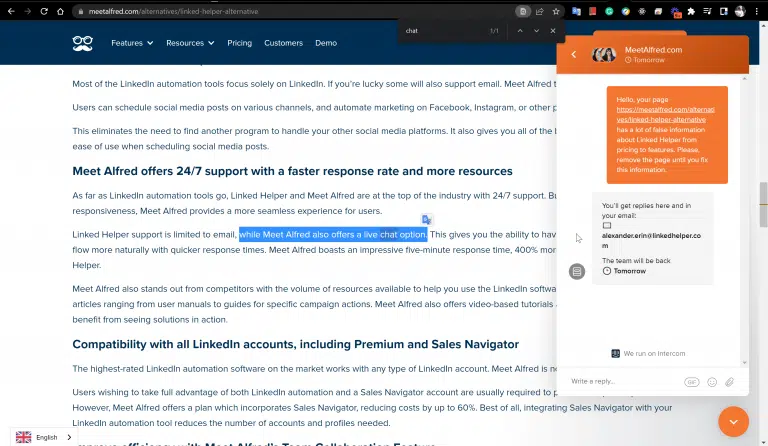
Try asking Linked Helper a question on a Sunday, and you will get a response within 30 minutes or sooner:
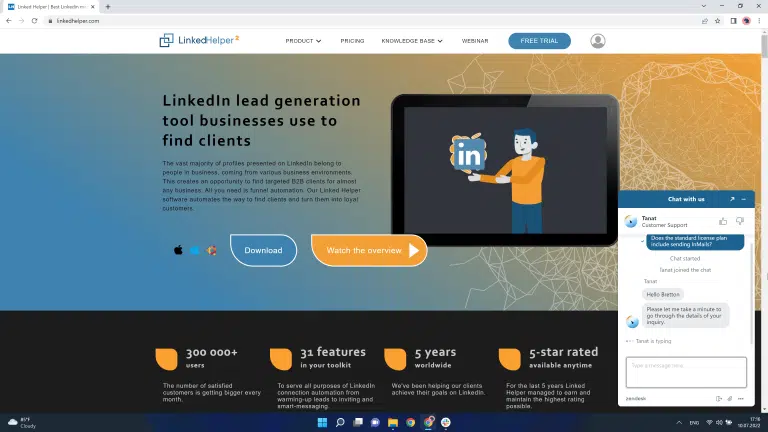
#2 Don’t spend time finding your unique value proposition or differentiating features
If your customers are primarily concerned with secure LinkedIn automation, it is enough to call your competitor “the most dangerous automation tool.” Say that they “leave obvious traces LinkedIn can detect easily,” when in fact, Linked Helper clicks buttons just as a human and works like a human in a browser, being completely undetectable.
Saying that your competitor “has no safeguard at all,” and “no warning is provided by them […] about risky behavior” sounds persuasive, too.
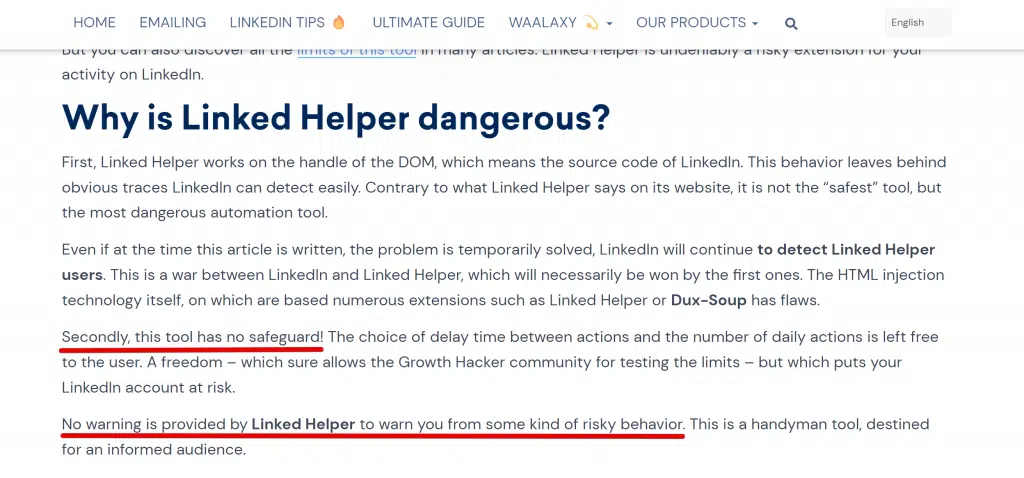
The reality is that the Linked Helper tool has a default cap of 150 actions per day per account. If you try to raise limits for certain actions, you will read a clear warning. Indeed, users can raise the total daily actions even to an astronomical 1,000 actions – but that’s only because certain actions (like sending profiles to webhooks) do not affect your LinkedIn account activity levels.

But again, who cares? False statements with strong language like “most dangerous” will scare your customers enough so they trust you and not Linked Helper.

#3 Hide your own flaws
Pointing at your competitor’s product as “dangerous” and “unsafe” draws customers’ attention away from your own tool’s safety flaws. Most people are not very knowledgeable about how various applications work and won’t know the difference between an extension and a standalone program in a technical sense. So why not use it to brag about your tool’s alleged safety?
Just as an example: to claim that Linked Helper “works on the handle of DOM, which means the source code of LinkedIn” or that it uses “HTML injection technology” will distract an unprepared audience from realizing that it is your product – and not Linked Helper – which works like this. Meanwhile, Linked Helper remains the safest solution that does not touch the API, nor does it use the code injection technique.
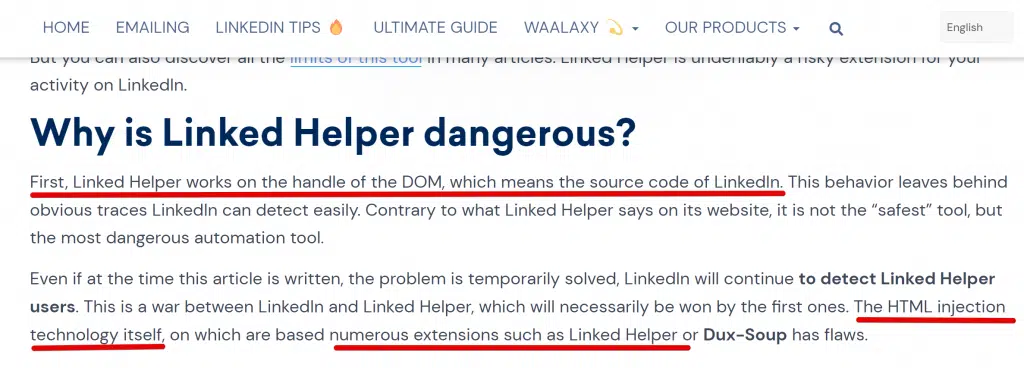
#4 Piggyback on your competitor’s strong brand name
When Linked Helper appeared on the market 6 years ago, it was a relatively new niche. However, a few players existed back then. Linked Helper managed to quickly grow its customer base (from zero to 70+ thousand downloads in the first year) and become the top-rated Chrome extension without criticizing other tools. Today it boasts 3,600 subscribers on YouTube and 40,000+ active users. We have every reason to say that Linked Helper has gained worldwide recognition. This was achieved through hard work aimed at creating new features and great experiences for our users. As new tools for LinkedIn automation started to emerge, it only pushed us to work harder. In certain ways our new competitors were ahead of us. Thus, by such criteria as “simplicity of UI”’ and being “cloud-based,” we have always acknowledged their advantage over Linked Helper. This was not a simple or fast journey for us by any means.
But what if you don’t have years to wait and want to take a short cut?
Just take all those googlers who search for Linked Helper and steal them! Mention Linked Helper whenever you write on your FAQ, do a page with pricing plans, or create a new article for your blog.

This will get you more site visitors who will read that Linked Helper is “outdated,” “unsafe,” and “dangerous.” Remember – in this scenario we are building our marketing on lies, so no need to verify or be truthful about what Linked Helper is really capable of doing.
#5 Make false product comparisons
Another great way to promote your product is to create a comparison table where you claim to have features that your competitor doesn’t. Usually customers will be grateful that you’ve done the work for them, so it’s easy for them to choose among so many alternatives. If you simply choose not to mention the strengths of your competitor’s product, it will be only half as persuasive as claiming some of their product’s features are nonexistent. So go ahead and say that your competitor doesn’t have certain features. And once done, don’t bother to check or verify from time to time if anything has changed.
For example, writing in 2022 that Linked Helper still doesn’t have:
…Random quota delays
…CRM/Zapier integration
…Campaign management
…Statistics dashboard
…a dedicated IP address for every account
and other features that in fact we now have is a lie. But it may work in your favor if customers won’t do their own checking.
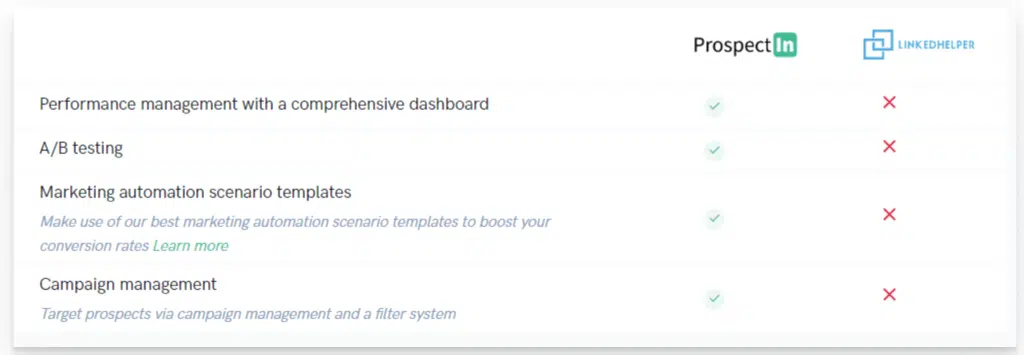
A 2-minute search through the Linked Helper’s Help Center using keywords like “A/B testing,” and “Statistics” returns very straightforward tutorials to prove that Linked Helper has everything required for smooth LinkedIn automation:
https://linkedhelper.zendesk.com/hc/en-us/articles/360019349660-How-to-duplicate-a-campaign-in-Linked-Helper-2 (searchable by keyword ‘A/B testing)
https://linkedhelper.zendesk.com/hc/en-us/articles/360017491719-Dashboard-menu (searchable by keyword ‘Statistics’).
What to do if you’ve fallen victim to someone’s unfair competitive practices
On a serious note, none of the above listed examples are a safe way to promote your products. It may yield short-term profit for you, but reputational damage will last long.
There’s nothing wrong with product comparisons themselves or even using your strong competitor’s brand to move up in the Google search rank. Targeting your competitors has been a legitimate way of advertising for a long time. It may take various forms. In contextual advertising, for example, it exists in the form of targeting users who search on Google for competitor brands. The so-called contextual display digital advertising (GDN) is targeting those who visit competitors’ websites. In out-of-home advertising, this is the installation of your advertising billboard near the office or sales points of your competitor – many of your potential buyers go there, and you can attract them with a more beneficial offer. This is often done by hypermarkets, shopping centers, and car service stations.
The devil is in detail, though. The method is fine as long as you don’t blatantly lie about your rival’s product.
To begin with, misleading customers about any of the product features is contrary to trade and competition law in most countries. Thus, the Federal Trade Commission in the United States works to “prevent unfair methods of competition and unfair or deceptive acts or practices in or affecting commerce.”
What do you do if you discover that someone is lying about your product publicly? Maybe our experience of dealing with it will serve you well.
#1 Gather data
You should begin by making a list of all false claims you’d like to see disappear from public view. Find out who is spreading lies about your product. Study their website upside down: check the FAQ section, product comparison pages, and blog – and list all inaccurate or false statements about your product.
Next, assess which claims could be regarded as a breach of law or easily proven to be false. Certain statements, even if you don’t like them, could be representing someone’s point of view – hence, it is hard to hold someone accountable for it.
#2 Try to settle it amicably first
Before taking the matter to court, it is worth sending an email to the key decision makers – the CEO most often – of the company that is spreading lies. The company’s management may be present on social media and in business-related social media groups.
Show them what you’ve found and ask them to remove the false information about your product. Most companies would prefer to resolve things peacefully rather than being dragged to court. But if you, like us, don’t succeed at this step, it’s time to take it down a formal path.
#3 Put together a C&D letter
The next step would be to draft a Cease & Desist letter in the name of a company owner or a senior executive. Call on a professional lawyer to help you or try finding examples on the Internet. By this time, you must have already found the management’s emails and contact details.
List all false claims you’ve found and, wherever possible, submit your proof. We’ve supplied every bullet point with a publicly available article from our Help Center that debunks the lie.
Once you send the letter through, in a positive scenario, your competitor will remove false information or update their content to match the real state of things.

#4 Write your own truth
As for the negative scenario, your last resort could be taking your opponent to court. But before you do that, why not use your blog as a weapon, too?
After the first shock of reading such blatant lies about our product subsided, we seated ourselves comfortably to write our own statement in defense of Linked Helper. We explained in detail why, contrary to what they claimed, Linked Helper is safe to use, while their product has serious security flaws:
Does litigation on false advertising ever succeed?
A few successful examples show that, yes, it does. Litigation on labeling, slander, or unfair competition can be a nerve-racking experience, but certain companies that practiced false advertising or lied about their rival’s product have been held accountable. In the CrossFit, Inc. v. National Strength and Conditioning Association case of 2016, the plaintiff, CrossFit Inc., filed a suit against NSCA for making unsupported claims about high injury rates of athletes who were training under the CrossFit programs. The court ruled in favor of the plaintiff and made the NSCA pay $3,997,868.66 as a sanction.
The boomerang method still works. If you still do not know how Linked Helper works, we suggest you go to the page and thoroughly familiarize yourself with its main features. Also, don’t forget to download and install the tool on your computer. After a few hours of use, you will understand exactly how it works.